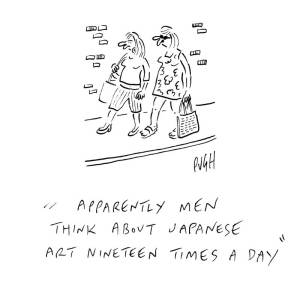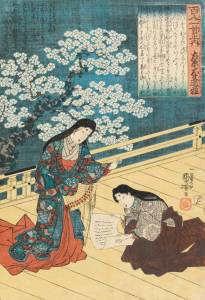Sex, famously, sells. If you make the trip to ‘Shunga: Sex and Pleasure in Japanese Art’ (currently on show at the British Museum) you will see that some things never change. When I visited the exhibition was packed, and the only way to see the works was to snake through the crowds slowly. There were no token glances; everyone was really looking.

Pugh appears courtesy of the Daily Mail
The press coverage of ‘Shunga’ has been noteworthy: the Sun ran a piece with the headline ‘Shunga Bunga’ after the museum revealed that the show was to carry an age restriction. A debate opened up in the Daily Mail about whether shunga was pornography or art, and Pugh created a gem of a pocket cartoon on the subject (pictured). The BBC settled for a carefully arranged image of Hokusai’s The Dream of the Fisherman’s Wife. But despite the press being titillated, the overriding opinion seemed to be that this was art, not pornography.
One man’s treasure is another man’s trash. The curators have tried to find a venue in Japan for the show to move to after it finishes in London, but according to Tim Clark, the chief curator, nobody wants it. Shunga, it seems, is still seen as pretty sordid in its homeland. Would the British Museum be happy to exhibit Victorian and Georgian pornography, transferred from a Japanese museum? Perhaps not.

Lover taking leave of a courtesan c. 1725–70), Suzuki Harunobu © The Fitzwilliam Museum
The Fitzwilliam Museum has also cottoned onto shunga’s appeal. To tie in with the British Museum’s show, it has opened up its own collection of shunga work in an exhibition entitled ‘The Night of Longing: Love and Desire in Japanese prints’. The display explores how love and desire were presented and accepted in Japanese art during the Edo and Meiji periods, c. 1600–1900. Work by some of the most famous artists of the time is on show, including pieces by Harunobu, Utamaro, Hokusai, Hiroshige and Yoshitoshi.
I was amused by the Fitzwilliam’s decision to exhibit its stash of oriental erotica. During the three years that I spent at Cambridge reading History of Art, this collection was never once mentioned. Indeed, when I set about working on an essay on erotic art in the Fitzwilliam, I was directed to William Hogarth’s Before (1730–1) and After (1731), and nothing was said of the real highlight.
The British Museum show includes works from the Secretum – a collection created officially in 1865 to store all historical items deemed to be obscene. Some of the shunga works come from the founding collection donated by George Witt, a connoisseur of antique smut. Confronted with his donation, the Victorians blushed, and locked it away. It used to be accessible only to married men with ‘scholarly’ interests. Nowadays, the collection has been broken up, with some of it on show, and some of it strategically stored away.
It’s great to see some of the shunga pieces proudly displayed on the museum’s exhibition walls – some of them really are rather beautiful. Perhaps now we can have a peek at what else remains hidden behind lock and key around Britain: imagine an exhibition showcasing all 1100 or so objects originally housed in the Secretum – how people would flock. If anything is going to get visitors through the doors of a museum, it’s an exhibition about sex.
‘Shunga: Sex and Pleasure in Japanese Art 1600–1900’ is at the British Museum, London, until 5 January 2014.
‘The night of longing: Love and desire in Japanese prints’ is at the Fitzwilliam Museum, Cambridge, until 12 January 2014

Sex on Show
Lovers in the upstairs room of a teahouse (c. 1788), Kitagawa Utamaro, from 'Utamakura' (Poem of the Pillow) © The Trustees of the British Museum
Share
Sex, famously, sells. If you make the trip to ‘Shunga: Sex and Pleasure in Japanese Art’ (currently on show at the British Museum) you will see that some things never change. When I visited the exhibition was packed, and the only way to see the works was to snake through the crowds slowly. There were no token glances; everyone was really looking.
Pugh appears courtesy of the Daily Mail
The press coverage of ‘Shunga’ has been noteworthy: the Sun ran a piece with the headline ‘Shunga Bunga’ after the museum revealed that the show was to carry an age restriction. A debate opened up in the Daily Mail about whether shunga was pornography or art, and Pugh created a gem of a pocket cartoon on the subject (pictured). The BBC settled for a carefully arranged image of Hokusai’s The Dream of the Fisherman’s Wife. But despite the press being titillated, the overriding opinion seemed to be that this was art, not pornography.
One man’s treasure is another man’s trash. The curators have tried to find a venue in Japan for the show to move to after it finishes in London, but according to Tim Clark, the chief curator, nobody wants it. Shunga, it seems, is still seen as pretty sordid in its homeland. Would the British Museum be happy to exhibit Victorian and Georgian pornography, transferred from a Japanese museum? Perhaps not.
Lover taking leave of a courtesan c. 1725–70), Suzuki Harunobu © The Fitzwilliam Museum
The Fitzwilliam Museum has also cottoned onto shunga’s appeal. To tie in with the British Museum’s show, it has opened up its own collection of shunga work in an exhibition entitled ‘The Night of Longing: Love and Desire in Japanese prints’. The display explores how love and desire were presented and accepted in Japanese art during the Edo and Meiji periods, c. 1600–1900. Work by some of the most famous artists of the time is on show, including pieces by Harunobu, Utamaro, Hokusai, Hiroshige and Yoshitoshi.
I was amused by the Fitzwilliam’s decision to exhibit its stash of oriental erotica. During the three years that I spent at Cambridge reading History of Art, this collection was never once mentioned. Indeed, when I set about working on an essay on erotic art in the Fitzwilliam, I was directed to William Hogarth’s Before (1730–1) and After (1731), and nothing was said of the real highlight.
The British Museum show includes works from the Secretum – a collection created officially in 1865 to store all historical items deemed to be obscene. Some of the shunga works come from the founding collection donated by George Witt, a connoisseur of antique smut. Confronted with his donation, the Victorians blushed, and locked it away. It used to be accessible only to married men with ‘scholarly’ interests. Nowadays, the collection has been broken up, with some of it on show, and some of it strategically stored away.
It’s great to see some of the shunga pieces proudly displayed on the museum’s exhibition walls – some of them really are rather beautiful. Perhaps now we can have a peek at what else remains hidden behind lock and key around Britain: imagine an exhibition showcasing all 1100 or so objects originally housed in the Secretum – how people would flock. If anything is going to get visitors through the doors of a museum, it’s an exhibition about sex.
‘Shunga: Sex and Pleasure in Japanese Art 1600–1900’ is at the British Museum, London, until 5 January 2014.
‘The night of longing: Love and desire in Japanese prints’ is at the Fitzwilliam Museum, Cambridge, until 12 January 2014
Unlimited access from just $16 every 3 months
Subscribe to get unlimited and exclusive access to the top art stories, interviews and exhibition reviews.
Share
Recommended for you
Note PAD
PAD London continues to diversify, and there’s plenty to tempt visitors during this busiest of weeks
First Look: Daumier
Catherine Lampert, curator of ‘Daumier (1808-1879): Visions of Paris’ at the Royal Academy of Arts, talks to Apollo
A Tribute to Anthony Caro
Sir Anthony Caro was among the giants of modernism. We can be certain that his influence will be felt for decades to come